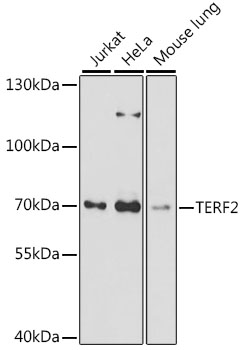Cell Cycle Antibodies 1
Anti-TERF2 Antibody (CAB16316)
- SKU:
- CAB16316
- Product Type:
- Antibody
- Reactivity:
- Human
- Reactivity:
- Mouse
- Reactivity:
- Rat
- Host Species:
- Rabbit
- Isotype:
- IgG
- Antibody Type:
- Polyclonal Antibody
- Research Area:
- Cell Cycle
Description
| Antibody Name: | Anti-TERF2 Antibody |
| Antibody SKU: | CAB16316 |
| Antibody Size: | 20uL, 50uL, 100uL |
| Application: | WB |
| Reactivity: | Human, Mouse, Rat |
| Host Species: | Rabbit |
| Immunogen: | Recombinant protein of human TERF2 |
| Application: | WB |
| Recommended Dilution: | WB 1:500 - 1:2000 |
| Reactivity: | Human, Mouse, Rat |
| Positive Samples: | Jurkat, HeLa, Mouse lung |
| Immunogen: | Recombinant protein of human TERF2 |
| Purification Method: | Affinity purification |
| Storage Buffer: | Store at -20'C. Avoid freeze / thaw cycles. Buffer: PBS with 0.02% sodium azide, 50% glycerol, pH7.3. |
| Isotype: | IgG |
| Sequence: | Email for sequence |
| Gene ID: | 7014 |
| Uniprot: | Q15554 |
| Cellular Location: | Chromosome, Nucleus, telomere |
| Calculated MW: | 32kDa/59kDa |
| Observed MW: | 70kDa |
| Synonyms: | TERF2, TRBF2, TRF2 |
| Background: | This gene encodes a telomere specific protein, TERF2, which is a component of the telomere nucleoprotein complex. This protein is present at telomeres in metaphase of the cell cycle, is a second negative regulator of telomere length and plays a key role in the protective activity of telomeres. While having similar telomere binding activity and domain organization, TERF2 differs from TERF1 in that its N terminus is basic rather than acidic. |
| UniProt Protein Function: | TRF2: Binds the telomeric double-stranded 5'-TTAGGG-3' repeat and plays a central role in telomere maintenance and protection against end-to-end fusion of chromosomes. In addition to its telomeric DNA-binding role, required to recruit a number of factors and enzymes required for telomere protection, including the shelterin complex, TERF2IP/RAP1 and DCLRE1B/Apollo. Component of the shelterin complex (telosome) that is involved in the regulation of telomere length and protection. Shelterin associates with arrays of double-stranded 5'-TTAGGG-3' repeats added by telomerase and protects chromosome ends; without its protective activity, telomeres are no longer hidden from the DNA damage surveillance and chromosome ends are inappropriately processed by DNA repair pathways. Together with DCLRE1B/Apollo, plays a key role in telomeric loop (T loop) formation by generating 3' single- stranded overhang at the leading end telomeres: T loops have been proposed to protect chromosome ends from degradation and repair. Required both to recruit DCLRE1B/Apollo to telomeres and activate the exonuclease activity of DCLRE1B/Apollo. Preferentially binds to positive supercoiled DNA. Together with DCLRE1B/Apollo, required to control the amount of DNA topoisomerase (TOP1, TOP2A and TOP2B) needed for telomere replication during fork passage and prevent aberrant telomere topology. Recruits TERF2IP/RAP1 to telomeres, thereby participating in to repressing homology- directed repair (HDR), which can affect telomere length. Homodimer. Component of the shelterin complex (telosome) composed of TERF1, TERF2, TINF2, TERF2IP/RAP1, ACD and POT1. Interacts with TERF2IP. Interacts with NBN. Interacts with SLX4/BTBD12. Interacts with DCLRE1B/Apollo and TERF2IP/RAP1; the interaction is direct. Ubiquitous. Highly expressed in spleen, thymus, prostate, uterus, testis, small intestine, colon and peripheral blood leukocytes. 2 isoforms of the human protein are produced by alternative splicing. |
| UniProt Protein Details: | Protein type:DNA-binding; DNA repair, damage Chromosomal Location of Human Ortholog: 16q22.1 Cellular Component: nucleoplasm; male germ cell nucleus; Golgi apparatus; chromosome, telomeric region; nuclear telomere cap complex; Mre11 complex; nuclear chromosome, telomeric region; cytoplasm; nucleus Molecular Function:protein C-terminus binding; protein binding; protein homodimerization activity; telomeric DNA binding; double-stranded telomeric DNA binding; chromatin binding Biological Process: negative regulation of telomere maintenance; telomere capping; negative regulation of telomere maintenance via semi-conservative replication; in utero embryonic development; telomeric loop formation; positive regulation of nitric-oxide synthase activity; positive regulation of telomere maintenance; telomere maintenance via telomerase; cell cycle; age-dependent telomere shortening; telomere maintenance; protection from non-homologous end joining at telomere |
| NCBI Summary: | This gene encodes a telomere specific protein, TERF2, which is a component of the telomere nucleoprotein complex. This protein is present at telomeres in metaphase of the cell cycle, is a second negative regulator of telomere length and plays a key role in the protective activity of telomeres. While having similar telomere binding activity and domain organization, TERF2 differs from TERF1 in that its N terminus is basic rather than acidic. [provided by RefSeq, Jul 2008] |
| UniProt Code: | Q15554 |
| NCBI GenInfo Identifier: | 613504836 |
| NCBI Gene ID: | 7014 |
| NCBI Accession: | Q15554.3 |
| UniProt Related Accession: | Q15554 |
| Molecular Weight: | 500 |
| NCBI Full Name: | Telomeric repeat-binding factor 2 |
| NCBI Synonym Full Names: | telomeric repeat binding factor 2 |
| NCBI Official Symbol: | TERF2 |
| NCBI Official Synonym Symbols: | TRF2; TRBF2 |
| NCBI Protein Information: | telomeric repeat-binding factor 2; telomeric DNA-binding protein; TTAGGG repeat-binding factor 2; telomeric repeat binding protein 2 |
| UniProt Protein Name: | Telomeric repeat-binding factor 2 |
| UniProt Synonym Protein Names: | TTAGGG repeat-binding factor 2; Telomeric DNA-binding protein |
| Protein Family: | Tricorn protease-interacting factor |
| UniProt Gene Name: | TERF2 |
| UniProt Entry Name: | TERF2_HUMAN |







